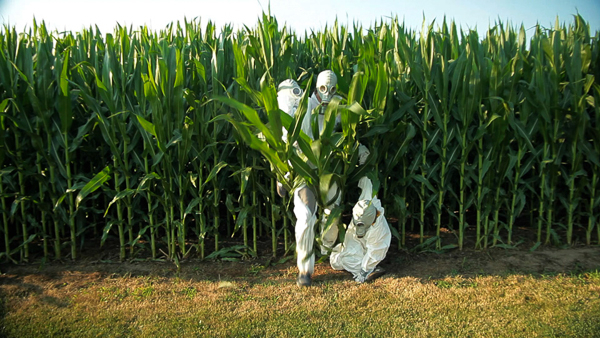
When Jeremy Seifert asked the public about GMOs, the overwhelming response was: “What the hell is that?”
To better understand what he was feeding his kids — Finn, 8, Scout, 6, and Pearl, 3 — Seifert, one of the directors of the 2013 documentary, “GMO OMG,” canvassed the country to get answers about possible ramifications of GMOs.
Genetically modified organisms (GMOs) are organisms whose genes have been altered to produce a desired trait by way of deletion, insertion and mutation. Genetically modified crops constitute 85 percent of processed foods in the U.S. For example, strawberries not labeled organic most likely contain the DNA of fish, which allow the strawberries to be frozen and remain fresh.
New York Public Interest Group (NYPIRG) of SUNY New Paltz held a screening of Seifert’s resulting documentary film “GMO OMG” on Tuesday, March 31 in the Student Union to help push legislation to mandate GMO labeling of food in the U.S.
Lauren Crawford, fourth-year international relations major and NYPIRG member at SUNY New Paltz, said they hosted the film screening because so many students are “ignorant on the subject matter of GMOs.” She said she supports the hypothesis that there is a “myriad of potential health and environmental risks” associated with GMOs that have not been tested for by the U.S. government.
The Food and Drug Administration (FDA) has deemed GMOs to be safe for consumption based on a three-month study on rats, which was not peer-reviewed.
Gilles-Eric Séralini, professor of molecular biology at the University of Caen, France and the president of the Committee of Independent Research and Information on Genetic Engineering (CRIIGEN), conducted a two-year study of GMO consumption on rats and found results in 2012 that conflicted those of the FDA.
The film reported that Séralini’s rats were afflicted with kidney, liver and mammary tumors after ingesting GMOs throughout their two-year life span. Estrogen levels doubled in male rats and their pituitary glands were harmed. These findings “erupted through Europe,” but in America all was still silent.
The first genetically modified foods were placed on grocery store shelves in the U.S. in 1994. The European Union mandated labeling of all GMO food products, including animal feed, in 1997, according to the film.
When Eddie Thomson, a third-year accounting major at SUNY New Paltz, was asked about his thoughts on GMOs in his food, he said “they scare the shit out of me.” Thomson said he looks for foods in the grocery store that do not contain GMOs, but always finds a limited selection of brands that directly state that their products do not contain GMOs.
“GMO OMG” chronicled Seifert’s trip to Norway to see the Svalbard Global Seed Vault. What Seifert called an insurance against extinction, in a country where GMO production is illegal exists in white caverns of cold, dry rock behind locked metal doors. Svalbard is home to tens of thousands of seed varieties, none of which have been genetically modified.
In the U.S. there are approximately 165 million acres of crops created with GMOs. The family farm that once predominated the U.S. is no more — less than two of the U.S. workforce is composed of small-scale farmers. Huge conventional farms using genetically modified seeds have taken over.
Monsanto, a sustainable agriculture company, has largely supplied these seeds to conventional farmers who claim that organic farming methods would not produce enough crop to feed the country.
Chelsea Rusinek, a fourth-year visual arts major, believes that GMOs have “potential to be a good thing,” but that they also have the potential to ruin free market and democracy for small organic farmers.
When Seifert went to Monsanto headquarters in St. Louis, Missouri, he was immediately escorted out of the building. Before his visit, he had called multiple times in attempt to learn the details of GMOs. None of his calls were ever returned.
The Rodale Institute, a 501(c)(3) nonprofit organization dedicated to pioneering organic farming methods, has 30 years of peer-reviewed research which supports the notion that organic farming techniques can in fact match the yield of conventional farms. Their research, the Farming Systems Trial, has also found that organic farms outperform conventional farms in times of drought and environmental stress.
Traveling the world in pursuit of answers, the only thing that Seifert was able to successfully conclude through the making of “GMO OMG” was that people are altering the world around us mostly for profit.
NYPIRG will be hosting a follow-up event to the screening of “GMO OMG” on a date to be announced. There a SUNY New Paltz nutritionist will teach students how to make healthier choices in the grocery store by avoiding foods containing GMOs.
